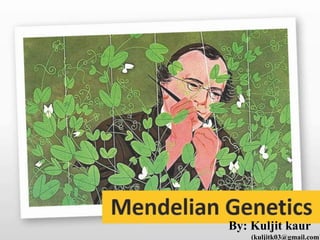
Mendelian genetics
- 2. What is Mendalian genetics ? Mendelian inheritance is a type of biological inheritance that follows the principles originally proposed by Gregor Mendel in 1865 and 1866, re-discovered in 1900 and popularised by William Bateson.
- 3. Gregor Johann Mendel • Austrian monk. • Born on 22 July 1822. • His father was peasant and his grandfather was gardener. • Was initially taught by local priest but later on he was admitted in an Institute of Philosophy. • He was not financially well to do therefore in 1843, he terminated his studies and went back to monastery in Brunn. • He was made incharge of garden at the monastery and named himself Gregor.
- 4. Gregor Johann Mendel • He became priest in 1847 • After 4 years he went to University of Vienna where he studied physics, mathematics , chemistry and botany. • When he returned to monastery after completing his studies , he took the position as a teacher of natural sciences at the Technical School.
- 5. Why Mendel chose peas ? • Mendel first started with mice. He thought he would take mice with different characters and make them mate , look at their offsprings and see if some pattern is there. • He did the same thing in honeybees. • Both experiments didn’t work out. • The problem is you can’t control when animals mate, right? • Eventually Mendel turned towards garden peas. • He found peas were perfect for his experiment.
- 6. Why Mendel chose peas ? • Why peas exactly ? • First it’s a plant he could control mating/ fertilization. • Peas have very short life cycle. Only take 3 months to grow to full height. Apple tree take 10 years so apple tree would be the worst candidate if you want to do a lot of experiments. • Pea plant have a lot of observable contrasting characters to experiments. Characters had only 2 contrasting traits.
- 7. 7 characters of pea plant
- 10. Conclusion
- 11. Terminology • GENE:Gene is the shortest segment of DNA responsible for the expression of its specific character. • Gene is also called as the basic unit of heredity. It is small DNA segment that determines a biological character of an organism. Gene is situated on chromosomes. • GENOME:It is the total genetic composition of an organism. • ALLELE:Allele is an alternate form of the same gene in which one is parental and other is maternal. In case of plant height, tallness and dwarfness are the two alleles of a gene.
- 12. • DOMINANT ALLELE:Out of two alleles, the one that is capable of expressing itself by hiding or suppressing its contrasting allele is known as dominant allele. • RECESSIVE ALLELE:Out of two alleles, the one that is being suppressed by its alternative allele is called as recessive allele. • Recessive is an allele that does not express itself when present with the dominant allele (in heterozygous form). • HOMOZYGOUS:A diploid individual carrying two identical alleles is known as homozygous. • It is pure for a trait or character.
- 13. • HETEROZYGOUS:A diploid individual carrying two different alleles is known as heterozygous or hybrid. • It is impure for a trait (T t) • GENOTYPE:A genotype is a genetic expression of an organism. • For plant height, TT, Tt and tt are the different genotype • PHENOTYPE:It is the physical or the observable expression of an organism. • It is the observable characteristic of an individual.
- 14. • CHARACTER:It refers to a general feature of an organism such as eye color, plant height etc. • HYBRID:The product of a cross between two genetically different individual belonging to the same genus or species or between two different genera is called hybrid. • MONOHYBRID CROSS:A cross between the two parents that are differing in one pair of alternating (contrasting) character is called monohybrid cross. • In this type, single character is used.
- 15. • DIHYBRID CROSS:A cross between the two parents that are differing in two pairs of alternating character is called dihybrid cross. • In this type, two contrasting characters are used. For example, seed shape and seed color (round yellow versus wrinkled green) • FILAL GENERATION:The progeny obtained as a result of crossing between parents is a hybrid progeny and is called First filial generation, represented by F1 (filial=offsprings). • The progeny obtained as a result of self-fertilization among F1 plants represents second filial generation represented as F2.
- 16. Mendel’s Laws Law of Dominance Law of Segregation Law of Independent Assortment
- 17. Law of Dominance
- 18. Law of segregation Law of segregation states that allele pairs separate or segregate during gamete formation and randomly unite at fertilization.
- 20. Law of Independent Assortment • Mendel's law of independent assortment states that the alleles of two (or more) different genes get sorted into gametes independently of one another. In other words, the allele a gamete receives for one gene does not influence the allele received for another gene
- 23. Kuljit kaur Lecturer Kanya maha vidyalaya (kuljitk03@gmail.com)